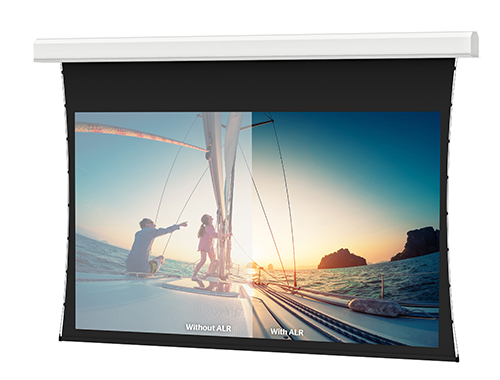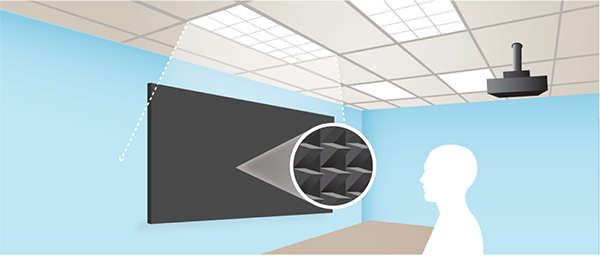Da-Lite has announced their latest ambient light rejecting surface, Parallax Stratos 1.0.
Here is what Da-Lite had to say about their new fabric...

This month, Da-Lite adds a new and exciting member to our ALR family and redefines existing Parallax surfaces as Parallax Pure.
Parallax Stratos 1.0
Da-Lite is delighted to introduce Parallax Stratos 1.0. Parallax Stratos is a high value ALR option that rejects up to 80% of ambient light with 1.0 gain for standard throw projectors (1.0:1 or greater). The new surface is available in tensioned electric and fixed frame screens to accommodate large scale installations. Seamless ALR screens can now be ordered up to 16 feet high with Parallax Stratos 1.0! See full list of expanded screen selections below.

Parallax Stratos is a little different than our existing Parallax surfaces though. It’s a Contrast Based ALR surface.
What is Contrast Based ALR?
Gray projection screens increase image contrast, particularly in a room that is not completely dark. These are also known as Contrast Based Ambient Light Rejecting screens. The gray color of the screen absorbs some of the ambient light rather than reflecting it. The same image in that space might appear washed out on a white screen, whereas the gray screen maintains and enhances contrast for viewers. Contrast Based ALR screens are single layer surfaces.
Parallax Pure
Parallax Pure are True Optical ALR surfaces available in gains of 0.8 and 2.3 for standard throw projectors and UST 0.45 for ultra short throw projectors. They reject up to 96% of ambient light, providing flat panel quality images up to 120” diagonal but without the glare and reflection of flat panels. When image quality is critical in high ambient light areas, Parallax Pure is the best solution.
What is True Optical ALR?
True Optical Ambient Light Rejecting screens are specifically designed to reject higher levels of ambient light from specific angles in a room. This makes the image brighter than Contrast Based ALR. Light in the room is not reflected in the image, preserving contrast, color saturation and dynamic range.
True Optical ALR screens consist of a series of optical layers rather than a single layer like Contrast Based ALR screens. There is a highly reflective base layer. On top of that a micro-layered optical lens surface absorbs light. This optical lens surface is itself made of two layers. One special layer is shaped like a microscopic saw-tooth that blocks light from above, and the second is a diffusion layer that filters out off-axis lighting.
This results in high-contrast, bright images in well-lit environments. However, one drawback of this complex surface structure is that screen size is limited to 120” diagonal in 16:9 fixed frame and electric products.

Illustration of the microscopic saw-tooth layer that blocks light from above in Parallax Pure surfaces.
To recap:
Parallax Pure 0.8, 2.3 & UST 0.45 = True Optical ALR
Select Parallax Pure when…
- The most ambient light rejection is needed in an installation
- Sizes are up to 120” diagonal in 16:9
- Image quality and resolution are critical
- A variety of gain types may be needed to accommodate projector models or lenses
Parallax Stratos 1.0 = Contrast Based ALR
Select Parallax Stratos when…
- High ambient light rejection is needed in installations
- Sizes are larger than 120” diagonal in 16:9
- Color and contrast need to be enhanced in the projected image
- A single surface solution with a variety of product types can solve the basic ambient light rejection needs of the project